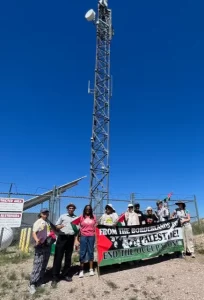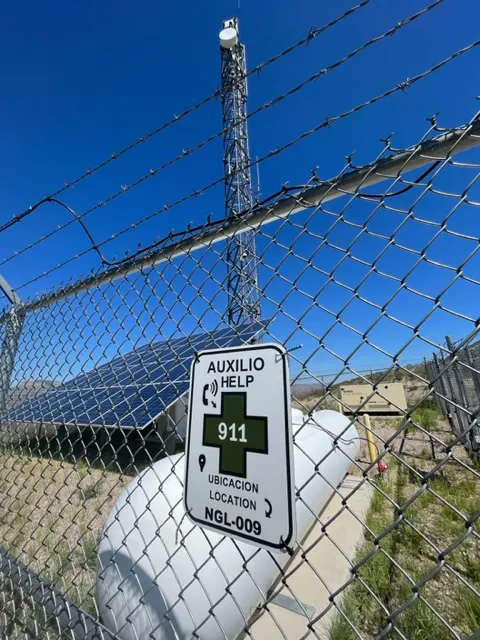The following article was originally published by Todd Miller on The Border Chronicle on August 22, 2024.
Will the mass slaughter in Gaza result in more profitable surveillance and weapons on U.S. borders? Sure looks like it, says the Australian author.
I interviewed Australian journalist and author Antony Loewenstein at the Elbit Systems tower in the Coronado National Forest near Nogales. Under this surveillance tower made by the Israeli company for border control, one of about 50 in southern Arizona, we stood at one of the most relevant examples from Loewenstein’s 2023 book The Palestine Laboratory: How Israel Exports the Technology of Occupation around the World. This is one of several booksLoewenstein has written or contributed to, and over the last year he has become one of the most sought-after journalists for comment about the ongoing situation in Gaza.
From where we talked, you could see mountains in Mexico, 10 miles to the south, within the scope of the sophisticated camera systems on the tower and its ground-sweeping radar, which has a radius of 13 miles. All around us the rolling hills looked lush from the summer rains, and across the canyon a lone Border Patrol vehicle was stationed on another hill, presumably watching over the valley, and probably eyeing us. The morning sun burned down as we stood near the tower’s buzzing generator, powered by a solar panel, when I began the interview.

Could you tell us a bit about your book and why it would be of interest to people in the U.S.-Mexico borderlands?
So the book came out in May 2023, and then October 7 happened. The book’s not about October 7 particularly, at all actually, but it gives the context for a lot of people about how we’re in this utterly insane, grim, ongoing mass slaughter in Gaza with seemingly no end.

Thinking of that and thinking of where we are standing right now, in the U.S.-Mexico borderlands in front of one of those exported technologies, can you give me your impressions? Is this your first time being on the U.S.-Mexico border?
The other reason I was interested in coming here was that I wanted to understand how the U.S.—often with Israeli and other countries help—tries to, in some ways, demonize migrants in not only a physical sense but also a technological sense.
And I guess in many ways seeing the border wall the last few days reminds me of the wall in Palestine. It’s different from the wall in Palestine. Palestine is more concrete. Here, I’m not sure what it’s made of, but it has barbed wire at the top. In Palestine people sometimes do cross the wall and jump over. Here, I understand it does happen occasionally too. And these Elbit towers are dotted across the borderlands.

You know, you look at this tower and people think, well it looks quite benign, it’s just a tower. A tower’s not a weapon per se. It’s not killing anyone directly. But what it does, it makes an enemy of people who are simply seeking asylum. They’re going to more dangerous areas. They may die of lack of water or from the heat.
I guess I wanted to come and see with my own eyes and to understand in some ways that what Israel is doing in Palestine is a model for the world. But I think increasingly what the U.S. is doing on its border is also inspiring other countries globally. So it’s a weird, unhealthy, parasitic relationship between two sadly very close allies.
Fair to say that people who are really interested in border issues and what’s going on in the U.S.-Mexico borderlands should also be interested in what’s going on in Israel/Palestine and how technology such as this is sold?
One of the things I talk about in the book is that what happens in Palestine doesn’t stay there. I mean even since October 7 and Israel’s insane response in Gaza, they’re testing weapons in Gaza. They’ve been testing them for years, and my book talks about this. But since October 7 we’re talking about testing new forms of weapons, new forms of killer drones, and already there’s been a number of global arms fairs, particularly in Paris and Singapore in the last four months, where companies are literally saying that [their product] has been battle-tested in Gaza. It’s not like it’s a secret. It’s not like somebody like me or you is making up these terms. They themselves, the Israeli companies, are saying it.
And you know what some people have said to me since October 7? Doesn’t your whole thesis about the Palestine laboratory get challenged when on October 7, when Hamas, which is a relatively low-level guerrilla movement—was able to breach the border, the wall/fence—and Israel defenses essentially melted away? Doesn’t that show that none of this works? In other words, that the technology fails? And that’s true, it did fail catastrophically for Israel on October 7. But there has been literally no evidence that I’ve seen nearly a year after that’s had any impact on countries looking into Israel as their defense model.
So even failure is not an impediment here.
Now it should be, you would think. I mean, the latest figures we have for Israeli arms sales for 2023 are the highest ever: $13.1 billion. And the sales went to a huge number of countries—to Europe and elsewhere. The October 7 failure had no impact. We don’t know what the figures will be for 2024, I guess we’ll see next year, but—
What do you think they’ll be?
I think they’ll be healthy.
The most ever?
Potentially. After the Russian invasion of Ukraine in February 2022, a huge number of European nations went to Israel and said help us, help us, send us the missile defense shield to protect us from what they thought, rightly or wrongly, what would be a potential Russian attack. Curiously enough, Israel has sold very little equipment to Ukraine. They were the country that was attacked. They don’t want to upset Russia. Because they want access to the skies over Syria to attack what they claim are the terrorists there. So Israel is not doing this for benevolent reasons.
I think the figures will be pretty healthy. There are growing numbers of nations that are interested in what Israel is doing in Gaza, including the massive increased use of artificial intelligence that Israel had tested before October 7 but has accelerated since in Gaza. There’s been some good reporting on that. And also there’s been huge involvement of mostly American cloud companies. Amazon, Google, and Microsoft have hugely expanded their presence in Israel since October 7. They are being used for the massive amount of data that Israel is using for targeting in Gaza.

And it’s probably pretty obvious for people reading this, but the targeting has been deliberately catastrophic. It’s not like they’re just going after the so-called terrorists. There have been 40,000 to 50,000 Palestinians killed, the majority civilians. Mass destruction is the point. Making Gaza unlivable is the point.
Although I would argue that they are not going to really defeat Hamas, and Hamas will remain standing in some form. Bloodied, yes. But not defeated.
In some ways the aim of Israel has been successful because Gaza is literally unlivable. Yes, there will be Gazans living there for years and decades to come. But there’s no infrastructure, there’s nothing physically there without huge amounts of rebuilding, and God knows where the funding will come from.
So my point is that we can argue that militarily, Israel, and frankly any Western state, always struggles with an insurgency. I mean, from Vietnam on, the U.S. hasn’t won a war in 50 years. They are incapable of winning wars. They keep doing them. They can’t win them. Israel’s the same. It lost in Lebanon. It’s arguably losing in Palestine, in Gaza. But that’s not the only judge of what is happening here. The judge is that Israel’s long-term goal has been to make life so horrific in Palestine that they’re living essentially as beggars. Or to physically push people out, Palestinians to Jordan, Egypt, somewhere. In that way, I’d say Israel has been successful in Gaza.
And could you also say that part of the “success” is when Israel can sell its products that it’s using in Gaza? And thinking specifically of border technology, do you know if that’s also something we’ve seen tested in Gaza since October 7?
Yeah, that’s a big part of it. What Israel has been doing in Gaza—apart from the obvious, which is killing people with drones and missiles—is doing huge amounts of surveillance and increasing amounts of data gathering.
And in terms of so-called borders, well yes, Israel has been using massive amounts of facial-recognition technology, biometric tools, as they are constantly forcing Palestinians in Gaza to move from north to south, from east to west. This is constantly evolving ethnic cleansing. They are trying to document, so Israel claims, where people are going, and the so-called militants among the local population. Well, the short answer is of course they are, because obviously. But that doesn’t impact how Israel is targeting people. They are just targeting people indiscriminately.
And I think what you see in Gaza and also globally—I’ve seen this for years—is that Israel sells itself not just as a model technologically but also as a model ideologically. And the U.S.—here along the U.S.-Mexico border—is buying this technology, because it’s been tested in Palestine. But there is also a real ideological affinity with Israel. Not just from evangelical Christians but from what we’ve seen in the U.S. political space. There is barely any room for dissent. And if you are a Democrat—I’m thinking of Cori Bush or Jamaal Bowman in the last six months, they were defeated by pro-Israel, in my view, fanatics through AIPAC. Even for Democrats, there is an attempt to extinguish even the handful of moderately critical voices in the U.S., and that’s not gonna change much if Trump gets in or if Harris does. Trump is Trump and he will be fanatically pro-Israel because the people around him are. And Harris has had a history of being quite frankly very similar.
So as always is the case, this won’t change from the top level, it will change from civil society and pressure. Without massive pressure on Israel, like with South Africa years ago, this isn’t going to change in Palestine.

El Tribuno del Pueblo brings you articles written by individuals or organizations, along with our own reporting. Bylined articles reflect the views of the authors. Unsigned articles reflect the views of the editorial board. Please credit the source when sharing: tribunodelpueblo.org. We’re all volunteers, no paid staff. Please donate at http://tribunodelpueblo.org to keep bringing you the voices of the movement because no human being is illegal.



